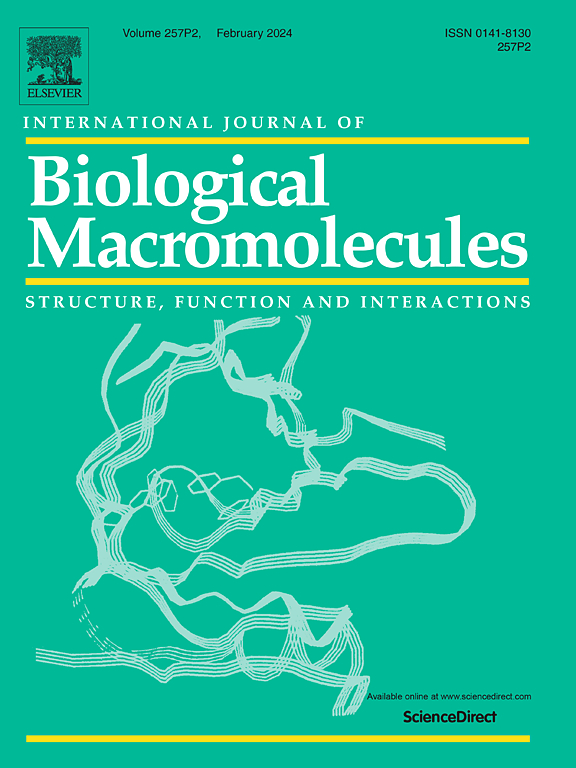Molecular and structural analyses of voltage-dependent anion channel 2 and its anti-apoptotic function in stress and pollutant resistance in Pacific abalone
IF 8.5
1区 化学
Q1 BIOCHEMISTRY & MOLECULAR BIOLOGY
International Journal of Biological Macromolecules
Pub Date : 2024-11-02
DOI:10.1016/j.ijbiomac.2024.137234
引用次数: 0
Abstract
This study aimed to identify voltage-dependent anion channel 2 (Hdh-VDAC2) and determine its functional role in response to acute thermal stress, H2O2-induced stress, heavy metal toxicity, bacterial and viral infections, and during metamorphosis. Structural analysis confirmed that Hdh-VDAC2 is a pore-forming β-barrel protein. Molecular docking further confirmed the protein-protein interactions of Hdh-VDAC2 with Hdh-BAX, Hdh-caspase 3, and Hdh-BCL2. In the Hdh-VDAC2-inhibited hemocytes (HCY), apoptotic genes (Hdh-caspase-3 and Hdh-BAX) exhibited elevated mRNA expression, while the anti-apoptotic gene (Hdh-BCL2) was downregulated. Further, fluorescent techniques confirmed excessive reactive oxygen species (ROS) production, lower cell viability, elevated caspase 3 activity, and increased DNA fragmentation in Hdh-VDAC2-inhibited HCY, indicating an anti-apoptotic role of Hdh-VDAC2 in Pacific abalone. Transcriptomic analysis revealed differential expression patterns, with upregulation in the digestive gland (DG) and downregulation in the gill (GIL) and HCY when comparing heat-tolerant (HT) versus heat-sensitive (HS) abalone groups. Additionally, both cold and heat stresses induced Hdh-VDAC2 expression. Other environmental factors including H2O2, cadmium, bacteria, and viruses, were also shown to induce Hdh-VDAC2 mRNA expression in the GIL and DG of Pacific abalone. During metamorphosis, the blastula (BLS) stage exhibited higher Hdh-VDAC2 mRNA expression. These findings suggest that Hdh-VDAC2 plays a crucial anti-apoptotic role and may be a biomarker for summer mortality in Pacific abalone.
电压依赖性阴离子通道 2 的分子和结构分析及其在太平洋鲍鱼抗应激和抗污染中的抗凋亡功能
本研究旨在鉴定电压依赖性阴离子通道2(Hdh-VDAC2),并确定其在应对急性热应激、H2O2诱导的应激、重金属毒性、细菌和病毒感染以及变态过程中的功能作用。结构分析证实,Hdh-VDAC2是一种形成孔隙的β-管状蛋白。分子对接进一步证实了Hdh-VDAC2与Hdh-BAX、Hdh-caspase 3和Hdh-BCL2之间的蛋白质相互作用。在Hdh-VDAC2抑制的血细胞(HCY)中,凋亡基因(Hdh-caspase-3和Hdh-BAX)的mRNA表达升高,而抗凋亡基因(Hdh-BCL2)则下调。此外,荧光技术证实,在 Hdh-VDAC2 抑制的 HCY 中,活性氧(ROS)产生过多,细胞活力降低,caspase 3 活性升高,DNA 断裂增加,这表明 Hdh-VDAC2 在太平洋鲍鱼中具有抗凋亡作用。转录组分析显示了不同的表达模式,耐热鲍(HT)与热敏感鲍(HS)组比较,消化腺(DG)表达上调,鳃(GIL)和HCY表达下调。此外,冷胁迫和热胁迫都会诱导 Hdh-VDAC2 的表达。其他环境因素,包括 H2O2、镉、细菌和病毒,也被证明能诱导 Hdh-VDAC2 mRNA 在太平洋鲍鱼的 GIL 和 DG 中表达。在鲍鱼变态过程中,囊胚期(BLS)的 Hdh-VDAC2 mRNA 表达量较高。这些发现表明,Hdh-VDAC2 起着关键的抗凋亡作用,可能是太平洋鲍鱼夏季死亡的生物标志物。
本文章由计算机程序翻译,如有差异,请以英文原文为准。
求助全文
约1分钟内获得全文
求助全文
来源期刊
CiteScore
13.70
自引率
9.80%
发文量
2728
审稿时长
64 days
期刊介绍:
The International Journal of Biological Macromolecules is a well-established international journal dedicated to research on the chemical and biological aspects of natural macromolecules. Focusing on proteins, macromolecular carbohydrates, glycoproteins, proteoglycans, lignins, biological poly-acids, and nucleic acids, the journal presents the latest findings in molecular structure, properties, biological activities, interactions, modifications, and functional properties. Papers must offer new and novel insights, encompassing related model systems, structural conformational studies, theoretical developments, and analytical techniques. Each paper is required to primarily focus on at least one named biological macromolecule, reflected in the title, abstract, and text.

 求助内容:
求助内容: 应助结果提醒方式:
应助结果提醒方式:


